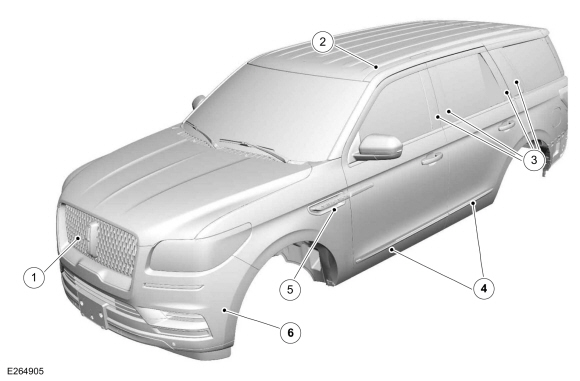Lincoln Navigator: Body Repairs - General Information / Plastic Repairs. Description and Operation
Plastic Components
The following illustration is not all-inclusive of trim levels available. The actual trim level of the vehicle will determine the viability of carrying out a plastics repair. Typically components with moulded-in color or a textured finish are not considered repairable components.
Exterior Plastic Components

| Item | Description | Material |
| 1 | Front grille | PC (Polycarbonite) + ABS (Acrylonitrile Butadine Styrene) |
| 2 | Roof ditch moulding | ASA (Acrylic Styrene Acrylonitrile) |
| 3 | Door and body appliques | PC (Polycarbonite) + ABS (Acrylonitrile Butadine Styrene) |
| 4 | Lower door mouldings | TPO (Thermoplastic Olefin) |
| 5 | Fender nameplate | ASA (Acrylic Styrene Acrylonitrile) |
| 6 | Front bumper cover | TPO (Thermoplastic Olefin) |

| Item | Description | Material |
| 1 | D-pillar moulding | ASA (Acrylic Styrene Acrylonitrile) |
| 2 | Rear Spoiler | PC (Polycarbonite) + ABS (Acrylonitrile Butadine Styrene) |
| 3 | Rear bumper cover | TPO (Thermoplastic Olefin) |
Repair Considerations
Several considerations will determine viability of plastic repair procedure(s):
- Is the damage cosmetic or structural?
- Can the repair be carried out on the vehicle?
- Is the part readily available?
- Is component repair the most cost effective method?
- Will the repair provide for the fastest, highest quality repair?
Several types of plastic are in use for automotive application. However, all plastics will fall into 2 primary categories of thermoplastic or thermosetting plastic.
Thermosetting Plastic
Generally, thermosetting plastics are made with 2-part thermosetting resins. When mixed together, heat is generated, producing a cure that is irreversible. Because of this, thermosetting plastics will require the use of a 2-part adhesive for repair.
SMC (Sheet-Molded Composite):
- SMC (Sheet-Molded Composite) is a type of thermosetting plastic that uses glass fibers or nylon fibers in combination with thermosetting polyester resins. When fully cured, SMC (Sheet-Molded Composite) is strong and rigid.
- SMC (Sheet-Molded Composite) is similar to, but not identical to fiberglass. Ford Motor Company uses SMC (Sheet-Molded Composite) in components such as fenders, hoods and liftgates.
Thermoplastic Compounds
Thermoplastic compounds are manufactured by a process that is reversible. Thermoplastics can be remolded repeatedly by reheating. This characteristic of thermoplastics makes plastic welding a possible repair alternative. A repair of thermoplastic compounds is still possible through the use of a 2-part adhesive and filler repair materials and reinforcements as needed. Thermoplastics are widely used in interior trim components, wheel flares, body side cladding and bumper covers.
Polyolefin
Polyolefins fall into the family of thermoplastics with one unique characteristic: an oily or waxy feel to the material when sanded or ground. Polyolefin lends itself very well to remolding through the use of heat. Because of this, components made of this material lend themselves well to the possibility of plastic welding. Most adhesive repair materials and paint will not bond to the surface of a polyolefin unless an adhesion promoter specially formulated for plastic is first applied to the exposed raw surface. Otherwise, polyolefins are repaired like most other thermoplastics. Polyolefins are used in bumper covers, fan shrouds and wheel housings.
Proper
identification of the various types of plastic is necessary to select
the appropriate repair method(s) to carry out high quality plastic
repairs.
For additional information, refer to: Plastic Repairs (501-25 Body Repairs - General Information, General Procedures).
.
 Impact of Insufficient Repair Quality. Description and Operation
Impact of Insufficient Repair Quality. Description and Operation
Body
repairs usually require a significant level of intervention in the
existing body shell structure. The corrosion protection, seals and NVH components are destroyed and must be replaced...
 Sealer, Underbody Protection Material and Adhesives. Description and Operation
Sealer, Underbody Protection Material and Adhesives. Description and Operation
Adhesives
The
correct adhesive bonding is essential to repairing the vehicle
correctly. Adhesives and mechanical fasteners are used in all areas of
the body structure in place of welding...
Other information:
Lincoln Navigator 2018-2025 Workshop Manual: Catalyst Monitor Sensor. Removal and Installation
Special Tool(s) / General Equipment 303-476 (T94P-9472-A) Socket, Exhaust Gas Oxygen SensorTKIT-1994-LM/MTKIT-1994-FTKIT-1994-FLM/FM Materials Name Specification Motorcraft® High Temperature Nickel Anti-Seize LubricantXL-2 - Motorcraft® Penetrating and Lock LubricantXL-1 - Removal All sensors With t..
Lincoln Navigator 2018-2025 Workshop Manual: Drive Pinion Flange and Seal. Removal and Installation
Special Tool(s) / General Equipment 205-002 (TOOL-4858-E) Installer, Drive Pinion Flange 205-126 (T78P-4851-A) Holding Fixture, Drive Pinion Flange 205-208 (T83T-4676-A) Installer, Drive Pinion Oil SealTKIT-1983-FTKIT-1983-FLMTKIT-1983-FX 303-144 (T79T-6316-A) Remover, Crankshaft Harmonic Balancer Flat Headed Screw Driver M..
Categories
- Manuals Home
- 4th Gen Lincoln Navigator Service Manual (2018 - 2025)
- Rear Bumper. Removal and Installation
- Power Running Board (PRB). Diagnosis and Testing
- Telematics Control Unit (TCU) Module. Removal and Installation
- Front Bumper Cover. Removal and Installation
- Windshield Washer Pump. Removal and Installation
Differential Case Runout Check. General Procedures
Special Tool(s) / General Equipment
 205-1016
205-1016Installer, Differential Bearing
TKIT-2014D-ROW2
TKIT-2014D-FL_ROW
 205-153
(T80T-4000-W)
205-153
(T80T-4000-W)
Handle
 205-D061
(D83T-4205-C2)
205-D061
(D83T-4205-C2)
Step Plate Dial Indicator Three Leg Puller Punch
